Making Fine Motor Skills Fun for Families at Home
Key Takeaways
- Engage your child in activities like threading beads, cutting with safety scissors, and paper crafts to enhance their fine motor skills.
- Use fun tools like blocks, playdough, sidewalk chalk, and putty to promote creativity while building fine motor skills.
- Encourage games like Jenga, Operation, and puzzles that combine fun with the development of fine motor skills and cognitive abilities.
- Incorporate fine motor skill activities into daily routines, such as buttoning clothes, using utensils, and finger painting.
- Seek guidance from healthcare providers like occupational therapists if you notice signs of struggle in your child’s fine motor skill development.
Understanding Fine Motor Skills
Fine motor skills are essential building blocks of childhood development. They encompass the mastery and coordination of small muscles, primarily in the hands, fingers, and wrists. These skills, often underestimated in their importance, are the foundation upon which children build their independence and academic success.
Engaging in activities that require fine motor skills, such as writing, drawing, or even simply using utensils, helps children establish a sense of autonomy. These skills also support participation in sports, games, arts and crafts, and other hands-on activities, fostering a child’s creativity and problem-solving abilities.
However, some children may face challenges in developing these skills. In such cases, occupational therapy can offer significant support. Through structured and targeted interventions, occupational therapists can improve children’s fine motor skills, thereby boosting their confidence and setting them on a path toward success.
Importance of Fine Motor Development
Building upon the understanding of fine motor skills, their importance to a child’s development cannot be overstated. These skills are critical for everyday tasks such as writing, dressing, and using utensils, as they involve the coordination of small muscles in the hands and fingers. Developing these skills not only leads to increased independence in children but also prepares them for more advanced tasks, creating a solid foundation for their future.
Providing opportunities to practice fine motor skills is critical. They are essential for activities like drawing, playing instruments, or using electronic devices. As your child grows and matures, these skills will become even more crucial. Activities that strengthen fine motor skills are not just about preparing children for school, specifically. They’re about equipping them with the tools they need to navigate the world independently.
In essence, fine motor skills development is a stepping stone to a child’s independence and success. Hence, parents and caregivers should understand the significance of these skills and ensure children are given ample opportunities to practice and enhance them. Remember, every small step your child takes is a significant leap forward in their developmental journey.
Home-Based Activities for Skill Enhancement
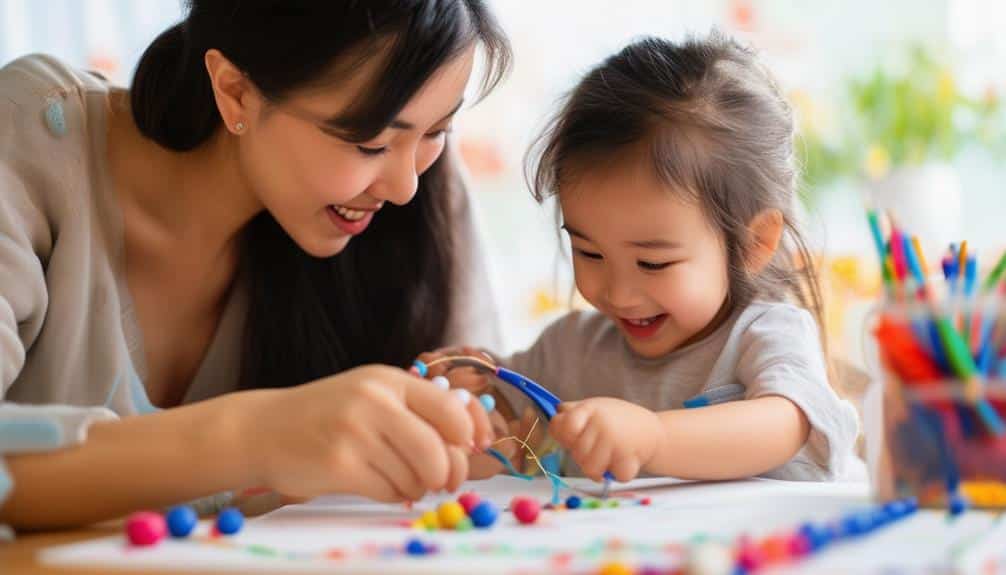
Regularly engaging your child in home-based activities can be a powerful and effective way to enhance their fine motor skills. Activities such as threading beads, cutting with safety scissors, and building with blocks not only entertain children but also help develop their dexterity and hand-eye coordination.
Encouraging your child to practice everyday tasks like buttoning and unbuttoning clothing, pasting items onto paper, and flossing teeth can further enhance their fine motor skills. These activities are not only practical but also pave the way for self-reliance in the future.
Take the opportunity to provide tools like blocks, puppets, and playdough, which can all serve as instrumental platforms for fine motor skill enhancement. These tools promote creativity while strengthening those essential skills.
However, be observant of signs of struggle, such as difficulty holding a pencil, using safety scissors, or brushing your teeth independently. Early intervention is pivotal, and healthcare providers, like occupational therapists, can be a great source of support. Remember that a child’s development pace is exceptional, so patience and consistent effort are crucial to fostering their skills.
Fine Motor Skill Activities for Infants
Though small in size, infants have an immense capacity for learning and can start developing their fine motor skills through activities that involve reaching, grasping, and transferring objects between their little hands. These experiences encourage fine motor development and lay a solid foundation for more intricate skills in the future.
Consider providing your infant with a variety of toys that offer different textures and shapes. This sensory exploration not only stimulates curiosity but also strengthens their tiny fingers and palms, enhancing their fine motor abilities. Engaging your child in simple activities such as finger painting or sensory play with materials like rice or sand can also support their fine motor development.
Moreover, you can encourage fine motor development by supporting the infant’s hand-eye coordination. Simple playtime activities like stacking blocks or rolling balls can benefit their fine motor skills. Though these activities may seem basic, they are essential in helping your child master the coordination of their small muscles.
Developing Motor Skills in Toddlers
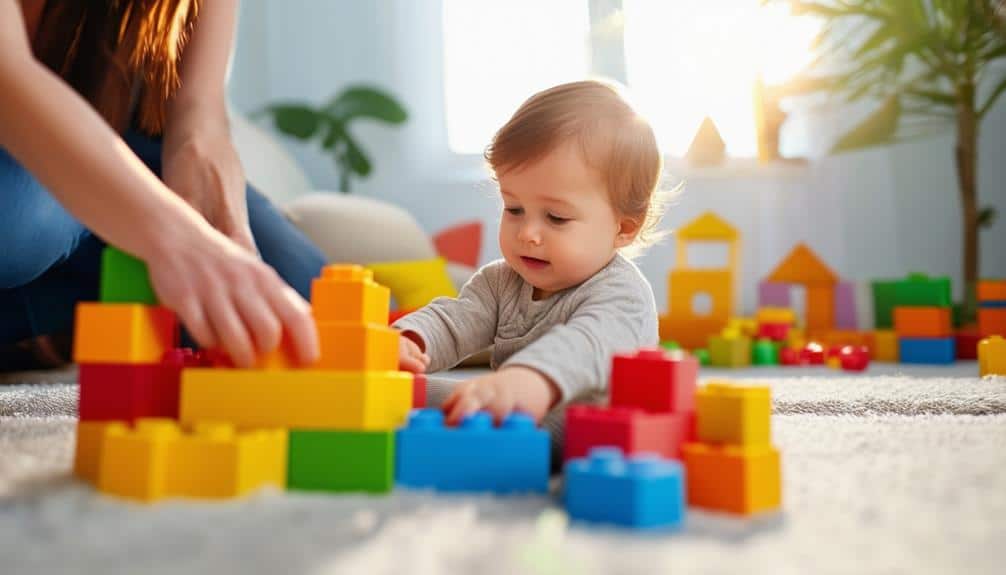
The journey of toddlerhood presents numerous opportunities for children to refine their fine motor skills, which are essential for accomplishing daily tasks and fostering self-reliance. Activities such as stacking blocks, threading beads, and finger painting not only entertain toddlers but also enhance their agility and coordination. Encouraging children to engage in these play activities can significantly contribute to their fine motor development.
Grasping and transferring objects is a practical way for toddlers to hone their hand-eye coordination, a critical aspect of fine motor skills. This seemingly simple task lays the foundation for more complex tasks in the future, like writing, drawing, and using utensils.
Incorporating activities that promote finger dexterity, such as squeezing playdough or using pegboards, can further develop toddlers’ motor skills. These activities not only develop their physical abilities but also boost their self-confidence as they gain mastery over their actions.
Kindergarten Activities for Motor Skills
As children move into kindergarten, a broader spectrum of activities becomes available to enhance their fine motor skills further, laying a solid foundation for their future academic pursuits. These activities pivot around developing hand-eye coordination, finger dexterity, and hand strength.
Children can build fine motor skills through activities such as cutting with scissors, threading beads, and building with blocks. These tasks not only engage the hands but also involve the eyes, fostering robust hand-eye coordination. Playing musical instruments or using tweezers further refines fine motor skills by encouraging precision and control.
Drawing with pencils is another beneficial activity, as it promotes finger dexterity and strength. Computer or tablet tasks involving a mouse or touchscreen offer a modern approach to motor skill development, adapting to the technology-centric world they are growing up.
Games that require catching or throwing objects support hand-eye coordination, making them fun and effective ways to develop motor skills. By incorporating these activities into a child’s routine, parents and educators can nurture the fine motor skills necessary for successful learning and development in kindergarten and beyond.
Benefits of Fine Motor Skill Development
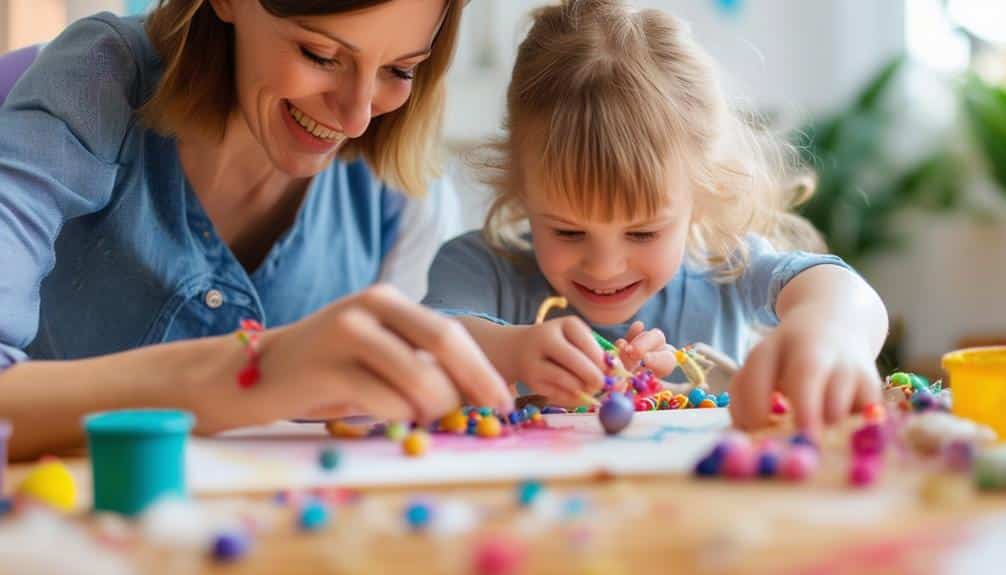
Without a doubt, the cultivation of fine motor skills in children reaps numerous benefits, ranging from enhanced hand-eye coordination and spatial awareness to superior academic performance. These skills are the building blocks of a child’s development, setting the stage for their successful future.
With improved handwriting and precision in arts and crafts activities, children with well-developed fine motor skills often outshine their peers academically. These skills are deeply intertwined with cognitive abilities, enabling children to learn better and faster.
Beyond academics, the benefits of fine motor skill development extend to everyday activities. Children with strong fine motor skills are better prepared for school tasks and activities, from tying shoelaces to using a computer keyboard. This enhanced capability fosters a sense of independence and self-confidence in children, which are vital aspects of their individual growth.
Engaging your child in activities that improve fine motor skills can significantly boost their overall development. In the upcoming sections, we will explore different ways to make this learning process fun and engaging. Remember that your involvement and encouragement are essential to their success. Tolet’sr, let’s support this child’s journey toward a bright and capable future.
Fun With Sticker Activities
Incorporating sticker activities during playtime can serve as a delightful and effective method for enhancing children’s fine motor skills. The process of selecting, peeling, and placing stickers nurtures their pincer grasp, a critical fine motor skill, and fosters hand-eye coordination. Children naturally love the vibrant colors and various shapes of stickers, making this an enjoyable and engaging way to build fine motor skills.
Sticker activities can be easily adapted to different difficulty levels. For instance, younger children can start with larger stickers and then gradually move to smaller ones as their skills improve. Encouraging them to peel off stickers from their own hands or clothes can further improve finger dexterity.
To add a layer of precision and control, draw open circles on a piece of paper and guide your child to place stickers within these boundaries. This enhances their ability to control the small muscles in their hands and fingers.
Stringing and Coin Activities

Stringing activities and coin activities, while seemingly simple, are powerful tools for enhancing fine motor skills in children. By threading Cheerios on a pipe cleaner or sorting and stacking coins, children can improve their hand-eye coordination, finger dexterity, and visual motor coordination. Not only are these tasks practical and adaptable, but they also provide a fun and interactive way for children to engage in their developmental journey.
Enhancing Coordination With Stringing
While it may seem simple, activities such as threading Cheerios onto pipe cleaners or strings can significantly improve a child’s two-handed and visual motor coordination, paving the way for robust development of fine motor skills. These tasks are both enjoyable and engaging, providing a creative and interactive medium for children to strengthen their hands and fingers.
These activities are also versatile and adaptable, catering to a wide range of ages and skill levels. This flexibility allows you to customize each activity to the child’s current abilities, creating a sense of achievement and encouraging further development.
Here is a basic chart that gives an overview of how stringing activities can enhance coordination:
| Activity | Skill Enhanced | Age Suitability |
|---|---|---|
| Threading Cheerios onto strings | Two-handed coordination, visual motor coordination | 3 years and above |
| Stringing beads onto pipe cleaners | Fine motor skills, two-handed coordination | 4 years and above |
| Weaving ribbons through a mesh | Fine motor skills, visual motor coordination | 5 years and above |
Incorporating these activities into playtime makes developing fine motor skills enjoyable for your child and allows you to support their growth actively in a practical and empathetic way.
Coin Activities for Dexterity
Expanding on the concept of stringing activities, introducing coins into the mix can add an exciting dimension to the development of a child’s fine motor skills and talent. Due to their small size and weight, coins provide an engaging challenge for children, elevating their hand-eye coordination and fine motor skills.
Coin activities such as sorting and stacking not only promote finger dexterity but also strengthen the hand muscles. These activities are designed to be fun, providing a playful context within which children can work on their pincer grasp, an essential fine motor skill.
In addition, threading coins onto string or sorting them into containers enhances hand and finger coordination. Such activities provide a tactile experience that is both enjoyable and educational. The tactile feedback from the coin’s metal surface can further support the child’s child’s fine motor skills.
Paper Crafts and Clothes
Engaging in paper crafts and clothespin activities offers children more than just creative play—it’s a fun way to strengthen their fine motor skills. Activities like cutting, folding, and pasting encourage the development of hand-eye coordination, finger dexterity, and hand strength. Whether they’re gripping scissors, folding colorful paper, or clipping clothespins, kids are building essential fine motor skills without even realizing it.
Paper crafts and clothespin activities are not just enjoyable but also beneficial. Each activity offers a distinct challenge that stimulates the mind and the senses, promoting cognitive and physical development. For instance, clipping clothespins onto objects helps enhance hand strength and coordination, which are essential factors for tasks like writing or buttoning clothes.
Parents, as primary educators and caregivers, can support a child’s satisfactory motor skill growth by incorporating these activities into playtime. While these tasks may seem simple, their impact on the child’s development is significant. By making fine motor skill development a fun and creative process, you guarantee it is a pleasurable experience for your child. Always remember that your loving support and guidance are critical in helping your child develop these crucial skills.
Outdoor Activities: Sidewalk Chalk
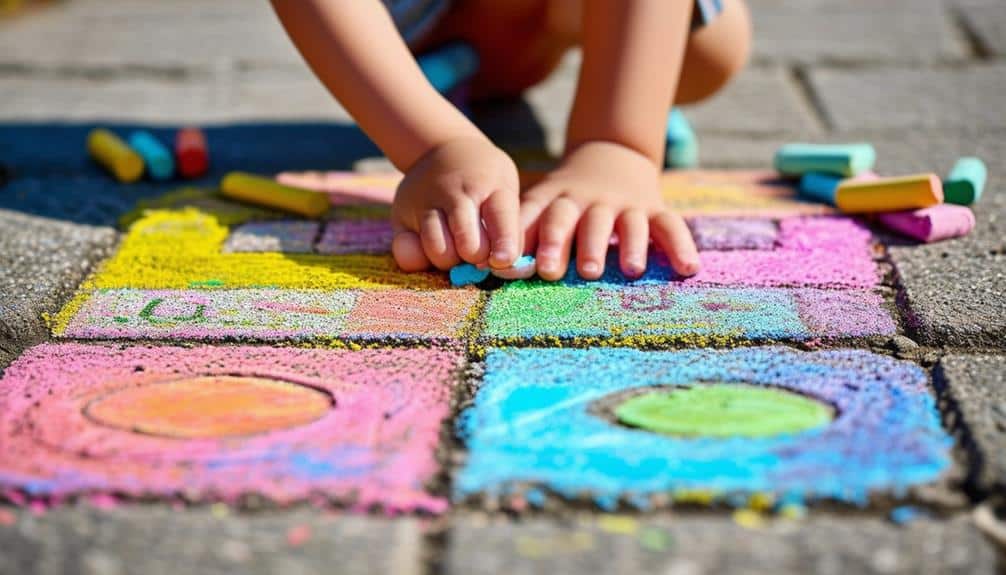
Moving outdoors, sidewalk chalk presents an exciting and creative opportunity for children to enhance their fine motor skills. This activity, often equated with fun and freedom, has far-reaching developmental benefits, especially in the realm of fine motor skills.
Drawing, coloring, and tracing with sidewalk chalk improves hand-eye coordination, an essential aspect of fine motor skill development. It’s not just about creativity; it’s about using those tiny muscles in the hand and fingers, refining their control and precision.
Children can also practice writing letters, numbers, and even shapes on sidewalks or driveways. This not only helps cement academic knowledge but also enhances the fine motor skills required for handwriting.
Moreover, sidewalk chalk activities encourage gross motor movement, which in turn refines fine motor control—squatting to draw, standing to observe, or stepping back to take in the whole picture all contribute to a child’s overall motor development.
Engaging in sidewalk chalk art allows children to express their creativity and imagination while simultaneously enhancing fine motor Skills. It’s a combination of fun and functionality that children love, and parents can appreciate.
Threading, Lacing, and Putty Play
Engaging in threading and lacing activities, such as stringing beads or lacing cards, can significantly enhance a child’s hand-eye coordination and fine motor skills. Similarly, the playful act of squeezing and molding putty not only strengthens hand muscles but also improves finger dexterity. These activities offer a fun and practical approach for children to develop their fine motor skills while also enjoying the process.
Benefits of Threading Activities
One cannot underestimate the profound benefits of threading activities such as threading beads, lacing cards, and putty play. These activities serve not just as engaging pastimes but as practical tools for children’s hand-eye coordination, fine motor skills, focus, and even sensory development.
Threading activities are enjoyable ways to develop hand-eye coordination and fine motor skills. The precise movements required to thread beads or lace cards help children practice control over their fingers and hands, thereby improving their fine motor abilities. In addition, these activities can help children focus as they concentrate on threading beads or lacing cards accurately.
Putty play is another valuable activity. It promotes hand and finger strength and hence enhances fine motor control and dexterity. This sensory-rich activity can also have calming and therapeutic effects, making it an excellent choice for children with sensory processing disorders or those who benefit from sensory stimulation.
Lacing Games for Coordination
Lacing games that involve threading beads or lacing cards captivate young minds while enhancing essential skills such as hand-eye coordination and fine motor abilities. These games offer a fun and engaging way to develop these skills, which are crucial for many everyday tasks such as writing, drawing, and even tying shoelaces.
Threading activities, a key element of lacing games, are excellent for promoting finger dexterity and hand strength. They require a child to use both hands in a coordinated way, improving bilateral coordination. Moreover, these activities demand precision and control, enhancing fine motor control.
As a parent, incorporating lacing games in a child’s playtime not only provides an enjoyable experience but also contributes significantly to their developmental progress. You can make these games more interesting by using beads or cards of different shapes, sizes, and colors. This will not only keep your child engaged but also stimulate their visual perception and cognitive skills.
Putty Play Strengthens Muscles
Putty play is an often overlooked yet highly effective method of fortifying hand and finger muscles. It offers a multitude of benefits for developing grip and dexterity and enhancing sensory processing. This simple yet potent activity can significantly impact fine motor skill development.
Putty play not only fortifies muscles but also enhances sensory processing and tactile awaits. It’s a fun, interactive way to improve muscle strength and sensory skills in children. By manipulating, squeezing, and stretching the putty, children work on their hand and finger muscles, promoting better grip and dexterity. This muscle development is vital for various tasks, such as writing, buttoning clothes, and using utensils.
Incorporating threading beads into putty play can further boost its benefits. This activity promotes bilateral coordination and refines finger manipulation skills. It encourages children to use both hands together in a coordinated manner, a necessary skill for many everyday tasks.
As parents, incorporating putty play into daily routines can provide a fun, engaging, and effective way for children to develop their fine motor skills. Putty play is proof that strengthening muscles can be as enjoyable as it is advantageous.
Games for Fine Motor Skills
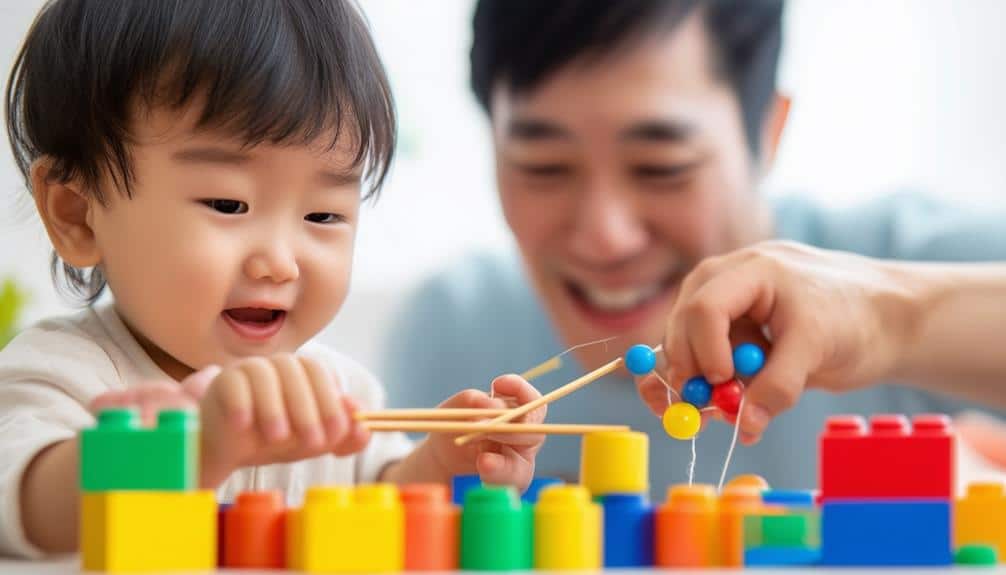
With an emphasis on improving hand-eye coordination, skill, and finger strength, games designed to enhance fine motor skills present a fun and engaging approach to child development. These games are not only entertaining but also play a critical role in skill development. They help children master the precise movements necessary in everyday life and academic settings.
Consider the following activities as effective and enjoyable ways to strengthen fine motor skills:
- Threading Beads: This activity enhances hand-eye coordination and precision. It also promotes concentration and patience.
- Playdough: Manipulating playdough can improve finger strength and creativity. It’s also a sensory-rich experience.
- Pegboards and Puzzles: These games require accurate hand movements and spatial awareness, enhancing agility and cognitive skills.
- Jenga, Operation, and Angry Birds: These popular games can improve coordination and control while also providing a fun challenge.
Tracing and Building Block Activities
Moving beyond traditional games, activities like tracing and constructing with blocks offer another dynamic way to enhance fine motor skills and hand-eye coordination in children. Tracing lines and shapes, for instance, can help a child gain more control over their hand movements. By drawing or tracing, they work on their ability to manipulate writing tools, which is an essential part of their academic and individual growth.
Constructing with blocks is another excellent activity for fine motor development. It requires precise manipulation of pieces, thereby strengthening hand muscles and improving spatial awareness. The process of stacking, arranging, and balancing blocks not only enhances their fine motor skills but also stimulates their creativity and problem-solving skills.
Frequently Asked Questions
How Can I Help Someone With Fine Motor Skills?
Engage in activities requiring precision, such as puzzles or bead threading, to aid in fine motor skills development. Promote tasks like buttoning garments or using scissors, and strengthen hand muscles via playdough squeezing or tong usage.
What Activities Can Help Develop Fine Motor Skills?
Activities such as threading beads, cutting with scissors, playing with playdough, building block towers, and practicing buttoning can greatly enhance fine motor skills, providing both fun and vital developmental support for children.
How Do You Best EncoChild’s Child’s Fine Motor Skills During the First Two Years of Life?
To enhance the child’s motor skills during the initial two years, engage them in activities that promote grasping, reaching, texture exploration, and hand-eye coordination. Introduce age-appropriate toys that stimulate both fine and gross motor development.
Conclusion
In summary, making fine motor skills fun at home is a beautiful way to support your child’s development while strengthening your family bond. By integrating playful activities into your daily routine, you’re not only helping your child build essential skills but also creating joyful moments together. Parents who take these extra steps deserve a big congratulations for their dedication to their child’s success.
If you have questions or need fresh ideas to keep fine motor skills fun, don’t hesitate to reach out to a pediatric occupational therapist. They can offer personalized tips and strategies to fit your child’s unique needs. Your commitment to helping your child grow and thrive is an investment in their future, and your efforts truly make a lasting difference!

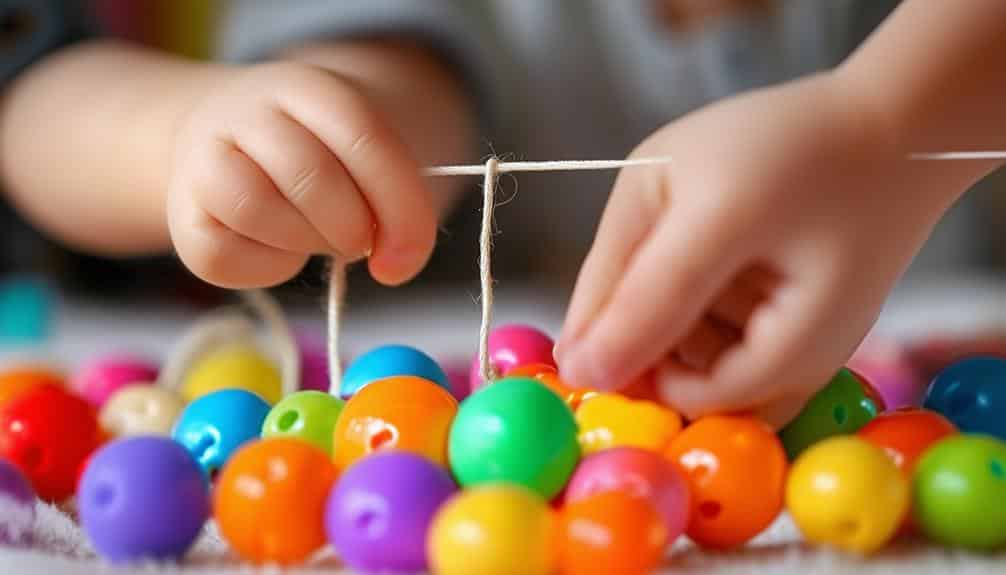
Recent Comments